In school, we learned that day-to-day activities like driving a car, running the AC, etc., require energy to run. And this energy is usually produced by burning fossil fuels which release greenhouse gasses into the atmosphere creating a carbon footprint.
But did you know that even sending or storing an email can have a carbon footprint?
This guide will tell you what an email carbon footprint is, the average carbon footprint of an email, and ways to lower your carbon footprint.
Table of contents
How to lower your email carbon footprint?
- What you can do as an individual:
- 1. Delete useless emails
- 2. Empty your email trash folder
- 3. Unsubscribe from unwanted emails
- 4. Turn off social media email notifications
- 5. Avoid sending one-word emails
- 6. Try to maintain inbox zero
- 7. Offset your carbon footprint
- What you can do as a company:
- 8. Stop sending unnecessary emails
- 9. Clean up your email lists
- 10. Don’t send heavy emails
- 11. Aim to become carbon neutral
What is the carbon footprint of an email?
Email carbon footprint is the volume of greenhouse gases (most commonly carbon dioxide) released into the atmosphere when an individual or community creates, sends, stores, and reads emails.
How do emails create a carbon footprint?
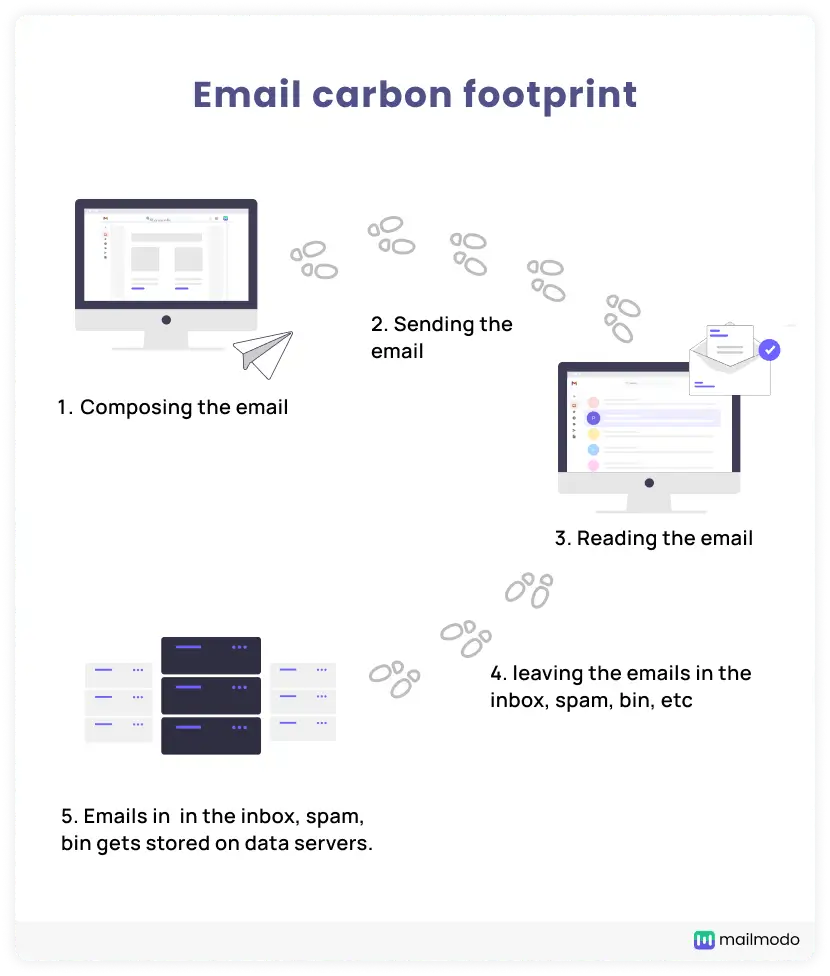
Here is how carbon dioxide is released by sending or storing an email.
- To compose an email, you use an electronic device (smartphone, tablet, laptop, or desktop) that requires energy. These devices are typically powered by electricity, usually generated from burning fossil fuels. So when composing and sending an email, you release a certain amount of CO2, thus creating a carbon footprint.
Now sending is only half of the journey; the rest depends on the person receiving the email.
- If the person doesn't delete the email, it gets stored on data servers, which takes a lot of energy to run. The longer someone stores an email, the more carbon footprint gets created. If the person deletes the email, it'll be removed from the data servers and not increase the carbon footprint.
The point that it consumes so much energy is not actually what contributes to its carbon footprint. Rather it's the fact that this energy is obtained from burning fossil fuels that emit greenhouse gas which is the reason for its carbon footprint.
And that's how sending and storing emails can create an email carbon footprint.
What is the average carbon footprint of an email?
All of this might sound vague, so let's look at some numbers to find out exactly how much an email's carbon footprint is.
However, before that, let me clarify a few terms so that you understand the stats better.
- CO2e - "Carbon dioxide equivalent"
CO2- represents only carbon dioxide emissions.
CO2e - represents carbon dioxide and other greenhouse gases (methane, nitrous oxide, etc.).
- Tonne
The carbon footprint can be measured in grams, but it's measured in tonnes for larger quantities.
1000grams (g) = 1 kilogram (kg)
1000 kilograms = 1 tonne
Now let's look at the numbers.
Mike Berners-Lee, an expert in carbon footprint, mentioned in his book "How Bad Are Bananas?" that an email has the following carbon footprint based on what type of email it is.
A spam email immediately picked up by your spam filters emits 0.03g of CO2e.
A short email sent from one phone to another emits 0.2g of CO2e.
A short email sent from one laptop to another emits 0.3g of CO2e.
A long email that took 10 minutes to write, 3 minutes to read, and is sent from one laptop to another emits 17g of CO2e.
An email that took 10 mins to write, sent to 100 people, emits 26g of CO2e.
This sounds like a small number, but when you look at the number of emails sent globally, this is pretty alarming.
In 2021, it was roughly estimated that 319.6 billion emails were sent and received each day. And, nearly 47% of them are spam emails, so nearly 150.2 billion emails were spam.
So, let's do some math. If one spam email emits 0.03g of CO2e, 150.2 billion spam emails emit 4.506 million grams of CO2e = 4.506 thousand kgs of CO2e = 4.506 tonnes of CO2e.
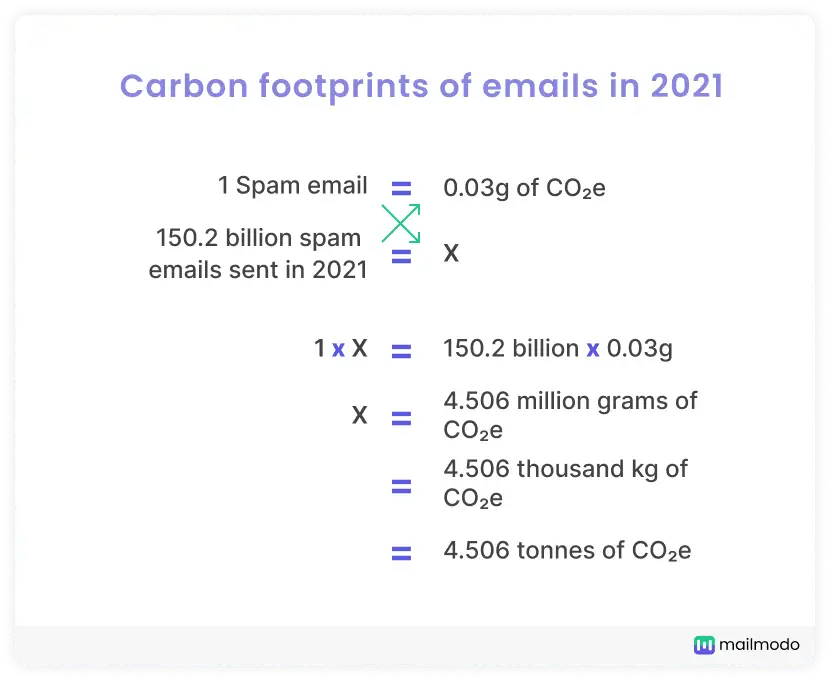
Now, let's assume the remaining 53% of emails are non-spam emails with average emissions of 10g of CO2e. So, 169 billion emails produce nearly 1.69 million kgs of CO2e = 1.69 thousand tonnes of CO2e.
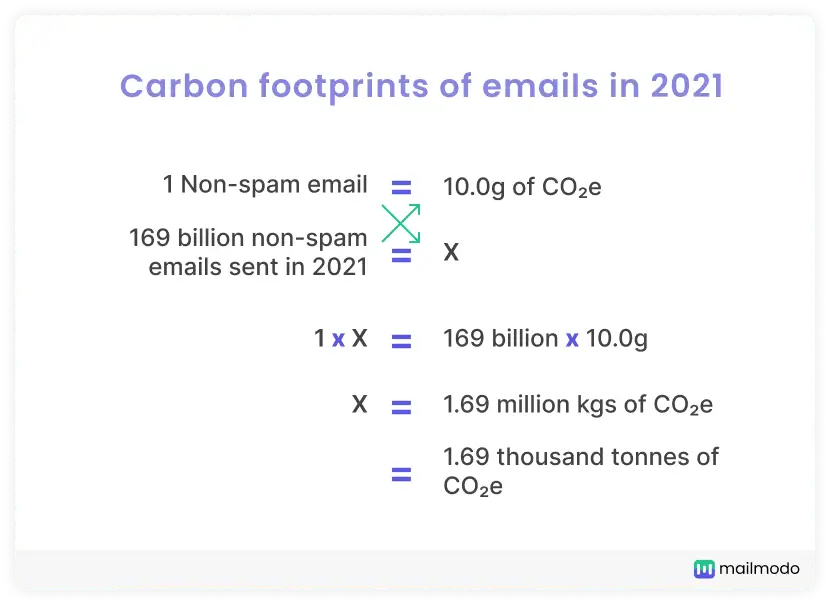
That's a huge amount of emissions, and it's almost equal to 1690 diesel cars driving 6000km each.
How to lower your email carbon footprint?
Now, we can't boycott emails from our day-to-day lives. We can take the following steps to reduce our email carbon footprint on the planet.
What you can do as an individual:
1. Delete useless emails
Spend time on your inbox and delete all the promotional and unnecessary emails. It'll get deleted from the server and no longer emit as much CO2 to store it. Do also ensure to check your spam folder and clear it as well.
2. Empty your email trash folder
You have deleted all your unwanted emails, don't stop there. Go to the trash folder in your email client and empty it. It'll permanently remove all your unwanted emails.
Some email clients automatically delete the emails in the folder after 30 days or 60 days. But if you don't want it idly sitting in the data server, you can regularly clean it up yourself to reduce your email carbon footprint.
3. Unsubscribe from unwanted emails
Over time, you might have subscribed to many different newsletters, promotional emails, etc. But it's highly unlikely that you read all or are even interested in that topic.
So you can simply unsubscribe from them the next time you receive an email you don't want. The unsubscribe option will usually be there at the end of the email, as shown in the image below.
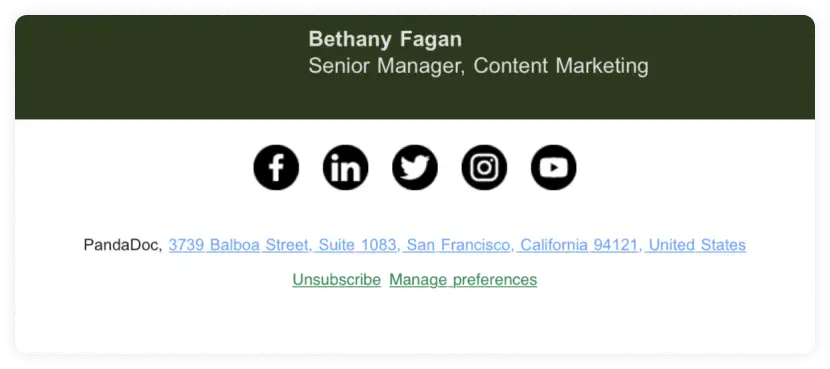
But if you feel like subscribing from each email is taking too long, you can use tools like Unroll.me to unsubscribe from several email lists at one go.
4. Turn off social media email notifications
When you sign up on a social media platform (Facebook, Linked In), you usually get email notifications from them about your activity or people you follow, like birthdays, achievements, etc.
These notifications also appear on the app, so turn them off unless it's necessary to be sent in email. It prevents unnecessary emails from being sent in the first place, thus having no carbon footprint.
5. Avoid sending one-word emails
Don't send any follow-up emails with just one word or line like “Thanks,” “Yes, sure,” “I will do it,” or “Have a good weekend.” All of these emails are unnecessary and can be avoided.
So, check your emails thoroughly before sending them to ensure they contain all the essential and accurate information to prevent the need for a follow-up email.
6. Try to maintain inbox zero
Inbox zero is an email management system where you delete, delegate, archive, or respond to the emails you get every day. This ensures that no unnecessary emails are left in your inbox and that only the most important emails are stored in your folders.
7. Offset your carbon footprint
Carbon offsets are any activities like afforestation, land restoration, renewable energy usage, etc., that compensate for the emission of greenhouse gases. They can directly absorb carbon dioxide or indirectly reduce greenhouse gas emissions by avoiding the use of fossil fuels.
So, you can calculate your email carbon footprint and fund such carbon offset activities to compensate for your emissions. You can use this calculator to gauge your email carbon footprint.
What you can do as a company:
8. Stop sending unnecessary emails
As a corporation, it is your responsibility to ensure that you do not send unnecessary promotional emails, especially if you want to lower your carbon footprint.
So, always think twice before sending emails. Does it provide value to the person receiving it? Do you need to send so many promotional emails or product emails? Are these people the right audience? If not the right audience, select the right people and send only to them rather than your entire email list.
Speaking of email lists, don't send emails to people who haven't subscribed to your email list. You are spamming them and increasing emissions.
9. Clean up your email lists
Remove any inactive subscribers in your email list who have not opened. I clicked on your email for more than 3-4 months. You can sunset them or put them in a separate suppression list to avoid accidentally sending them emails.
Related guide: How to Use Sunset Policy to Boost Your Email Engagement
10. Don’t send heavy emails
You might send HTML emails with many images/GIFs, which makes the email heavy in terms of storage size and thus takes more energy to send and store.
Reduce the size of your emails to reduce the energy required to send them. Due to the size reduction, your campaigns also tend to load faster, which improves the user experience. So it's a win-win situation.
11. Aim to become carbon neutral
Carbon neutral means that your company can offset the carbon emissions produced by all the different activities to run the company. You can go carbon neutral by offsetting, as mentioned above.
Or you can convert from fossil fuels to renewable energy sources to run your company building, transportation, etc. You can also replace old technology or renovate your infrastructure to be more energy efficient.
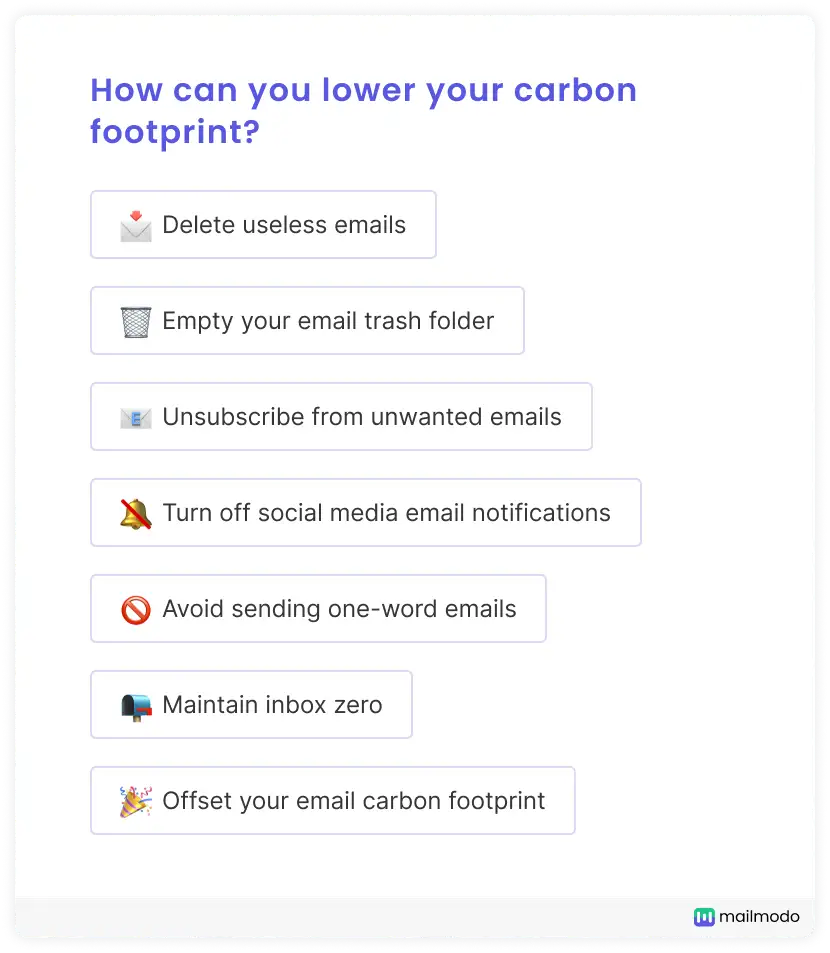
Be conscious of your impact on the planet
Sustainability is constantly improving, and it's becoming easier for people to reduce their impact on the planet. So, keep yourself updated on the latest sustainable developments to see how you can best reduce your email carbon footprint.
Till then, keep cleaning up your inbox daily and maintain inbox zero. Your efforts as an individual to reduce your carbon footprint will inspire others to follow in your footsteps. If you want to know more about attaining inbox zero, check out our guide.
"You cannot do all the good the world needs, but the world needs all the good that you can do."- Shelbi
What you should do next
Hey there, thanks for reading till the end. Here are 3 ways we can help you grow your business:
Talk to an email expert. Need someone to take your email marketing to the next level? Mailmodo’s experts are here for you. Schedule a 30-minute email consultation. Don’t worry, it’s on the house. Book a meet here.
Send emails that bring higher conversions. Mailmodo is an ESP that helps you to create and send app-like interactive emails with forms, carts, calendars, games, and other widgets for higher conversions. Get started for free.
Get smarter with our email resources. Explore all our knowledge base here and learn about email marketing, marketing strategies, best practices, growth hacks, case studies, templates, and more. Access guides here.


